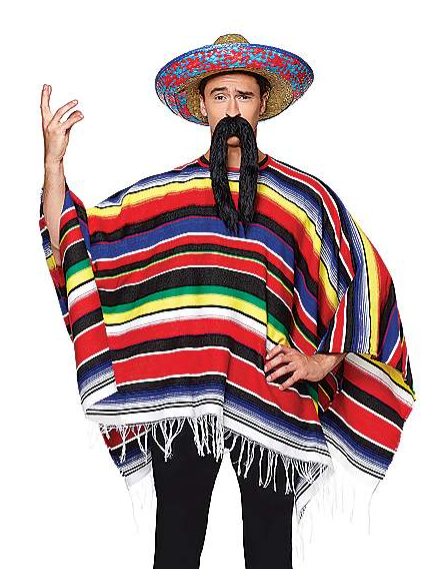Halloween Retrospective: Why You Still Can’t Dress as “Mexican”

COURTESY OF SPIRIT HALLOWEEN
Try again. May I suggest something from Fortnite?
November 16, 2018
Can you imagine being stopped for “random” check ups at every airport because you are Muslim and then seeing someone dressed as a “terrorist” for Halloween? Could you understand how it feels to be a Mexican living in the United States, to have your people constantly be called rapists and “bad hombres” by the president, and then see a white person with a sombrero getting drunk on Cinco de Mayo? If you are neither Muslim nor Mexican, you truly can’t. Unless your culture is the one being appropriated, you will never fully grasp the harm cultural appropriation does, and your opinion on the matter is irrelevant.
Defenders of such a narrative claim that policing what people can and cannot wear impairs creativity and freedom of expression. However, they completely ignore the the fact that dressing as another race goes far beyond a mere Halloween costume.
Being able to dress as Mexican for Halloween relies on a deeply rooted flaw of our country: the belief that minorities and marginalized groups are less than human. When you strip minorities of their personal identity and forget the hardships they face in the United States as a consequence of being black, Asian, Hispanic, Muslim, or any type of marginalized group, it is easy to adopt some aspects of their culture (i.e. dialect, dress, etc.) with no worry of being disrespectful. Chad, I hear you. But your freedom of expression does not supercede the right to dignity and respect for every American and their culture.
The term cultural appropriation has been used so much on the internet that it has lost its impact. People who call out cultural appropriation are made fun of by those who believe it is a myth. However, it is still a relevant topic today that greatly affects minorities across the U.S. Most people who dress as another race during Halloween do so with no malicious intent. But this does not exempt them from doing something wrong, however; good intentions mean nothing if the result is inherently harmful.
We see examples of appropriation constantly from the Kardashian sisters. From Khloe using a Native American headdress on multiple occasions to Kylie posting an Instagram picture basically in blackface, the Kardashians have a pretty bad track record when it comes to appropriating aspects of other cultures. What is most troubling about the Kardashians is that all of them have huge platforms and could inform their fans on movements like Black Lives Matter or issues like the erasure of Native American history, yet they continue to take only the elements of a culture that are palpable to their fans. Instead of calling attention to police brutality targeted towards black youth, they put their hair in cornrows; instead of talking about the discrimination Muslims face in the U.S. today, Khloe wears hijabs. Minorities are discriminated against for the same things they do, except when Muslims wear hijabs they are called terrorists, and when black people wear cornrows, they are called ratchet.
Those who argue that people are simply being too sensitive may not grasp how easy it really is to be unproblematic on Halloween. A look to Google’s “Frightgeist,” a costume popularity tracker, reveals the likes of “Fortnite,” “Spider-Man,” and dinosaurs atop the list of what everyone wore this past Oct. 31.
And it doesn’t have to stop at Halloween, nor should it. Dressing up for theme parties, demonstrations and “First Thanksgiving” plays should always beg the question: When wearing something evocative of a culture that is not your own, does your costume pay respect to the traditions it represents? Or are you really just making fun of Mexicans?










